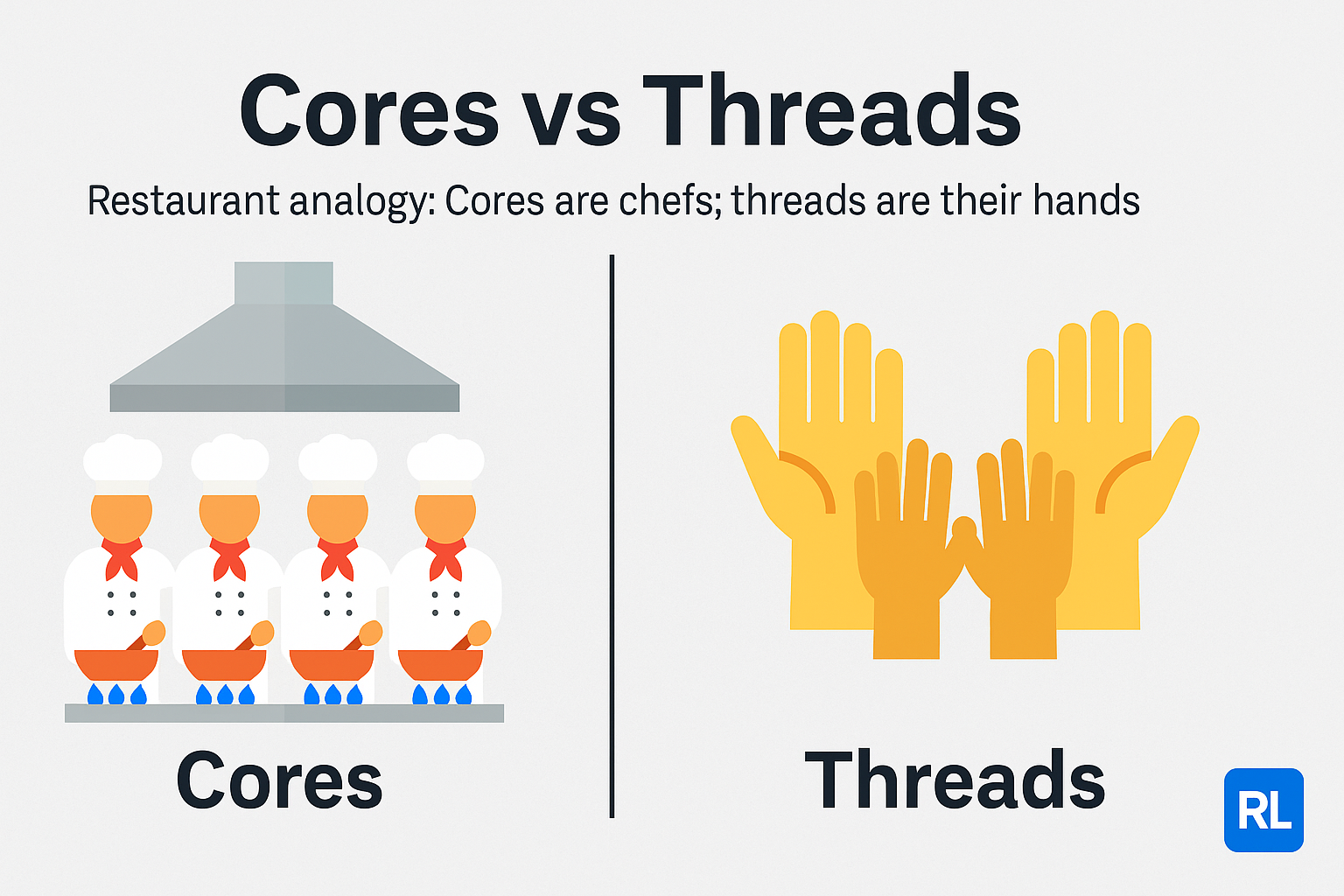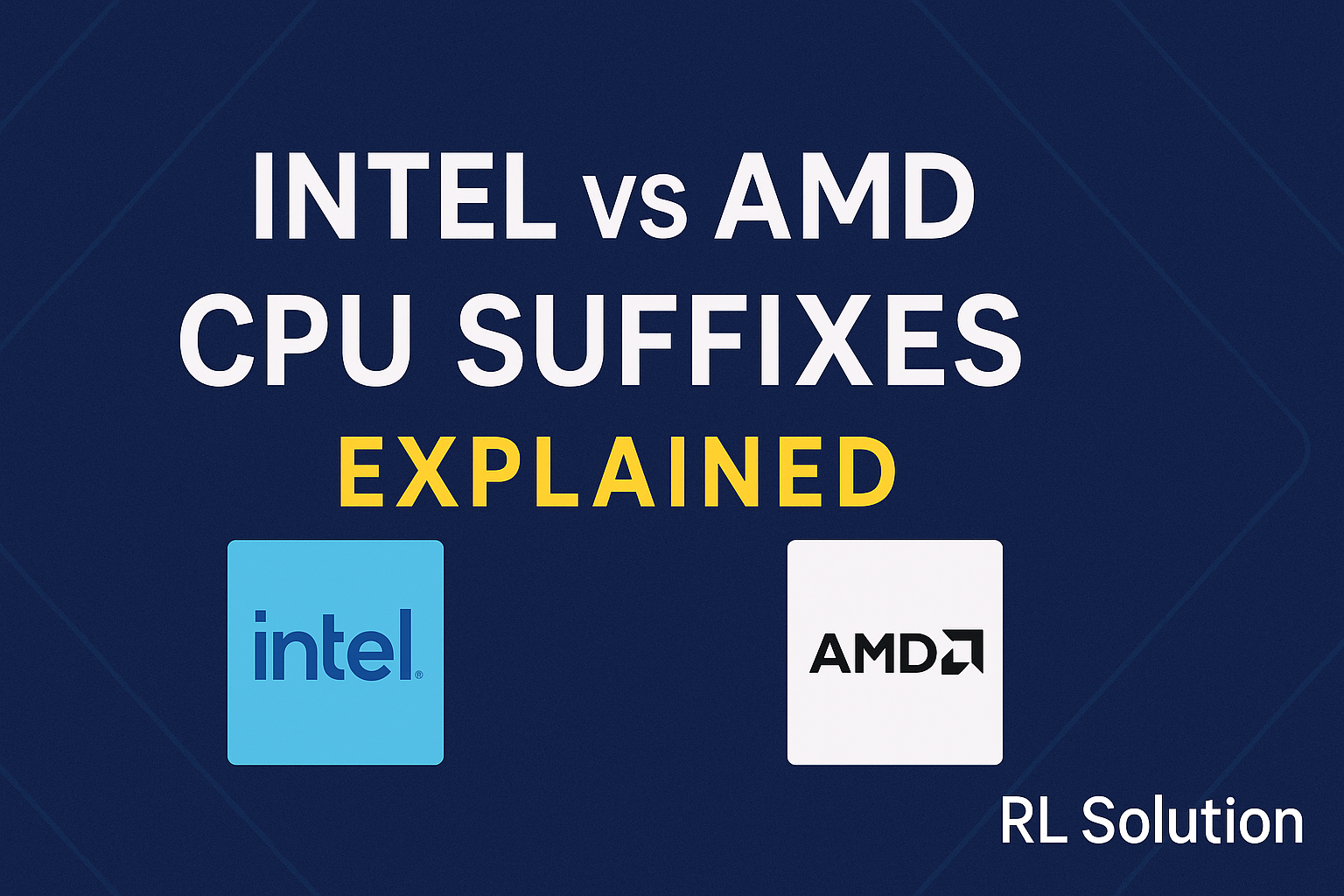When you look at a processor’s specs, you’ll often see numbers like 6 cores, 12 threads or 8 cores, 16 threads. For beginners, these terms can feel like marketing jargon. But they’re actually at the heart of what makes a CPU fast — or frustratingly slow.
At RL Solution, we believe that understanding these basics is the difference between buying blindly and buying smart. Let’s break it down in simple language.
🧩 What Are CPU Cores?
Think of a CPU as a brain. A core is like one thinking unit in that brain.
- Single-core CPU (old days): One worker doing all the tasks.
- Multi-core CPU (today): Several workers in one office, each able to handle tasks simultaneously.
Example: If you have 8 cores, your processor has 8 independent units that can work in parallel.
🔄 What Are Threads?
Threads are the virtual helpers inside each core.
Thanks to a technology called Simultaneous Multithreading (SMT) (or Hyper-Threading for Intel), a single core can handle two tasks at once by splitting resources.
So:
- 6 cores with SMT = 12 threads
- 8 cores with SMT = 16 threads
Threads aren’t as powerful as real cores, but they make multitasking smoother.
🎮 Real-World Examples
Student Example:
If you’re compiling a Java project on a 2-core/4-thread laptop, the system can juggle compilation + browser + music without freezing.
Gamer Example:
Modern games like Cyberpunk 2077 or GTA V benefit from higher core counts. But many still depend heavily on strong single-core performance.
Developer Example:
If you’re running Docker containers, virtual machines, or heavy data processing – more cores & threads = less waiting time.
⚡ Cores vs Threads: Key Differences
- Cores = Physical hardware
- Threads = Virtual splits of those cores
- Cores give raw power, threads improve efficiency
Analogy:
- A restaurant with 4 chefs (cores).
- Each chef has 2 hands (threads).
- More chefs = more dishes cooked at once.
- Extra hands = chefs can multitask, but not double their power.
📊 How Many Cores Do You Actually Need?
Here’s a quick guide based on use case:
- Students / Office Work: 2–4 cores, 4–8 threads (i3 / Ryzen 3)
- Gamers: 6–8 cores, 12–16 threads (i5 / Ryzen 5 or 7)
- Developers / Content Creators: 8–12 cores, 16–24 threads (i7 / Ryzen 7/9)
- Workstations (3D, VFX, CAD): 16+ cores, 32+ threads (Threadripper, Xeon, EPYC)
🧯 Common Misconceptions
❌ “More threads = more performance.”
👉 Threads help, but they aren’t a replacement for real cores.
❌ “Games use all cores.”
👉 Many games are optimized for 4–6 cores, but newer engines scale better.
❌ “I don’t need cores for coding.”
👉 Even students benefit from multi-core when running IDEs, browsers, and compilers together.✅ Solution: Choose one with a G, GE, or no suffix (Intel) if you don’t plan on buying a GPU.
🔍 Quick Case Study
Imagine two CPUs:
- Intel Core i5-12400F: 6 cores / 12 threads
- Ryzen 5 5600G: 6 cores / 12 threads
Both look the same on paper, but the Intel chip has stronger single-core performance, while AMD includes a GPU.
👉 Lesson: Cores and threads matter, but architecture and extras (like iGPU) can tip the balance.A: Yes! As long as you have a discrete GPU, AMD and Intel CPUs with no suffix are great performers.
✅ Final Thoughts from RL Solution
When it comes to cores vs threads, it’s not about having the biggest number — it’s about matching your processor to your real-world needs.
At RL Solution, our advice is simple:
- Students: focus on balance
- Gamers: prioritize cores + strong single-thread speed
- Developers: go big with multi-core setups
Understanding this difference will make you a smarter buyer — and a faster problem solver.
📥 What’s Next?
Want to:
- Get a cheat sheet version of this post?
- Watch this in 60 seconds as a YouTube Short?
- See how these CPUs perform in real builds?
👉 Subscribe, comment, or reach out at info@rlsolution.in


Leave a Reply